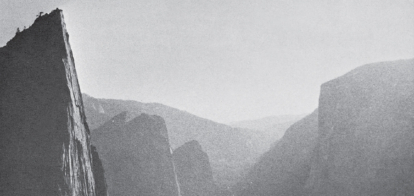A Word …
Below is the introduction to the 1972 Chouinard Equipment catalog—the first edition that was more than just order forms—written by Yvon Chouinard and Tom Frost. Though Chouinard Equipment was, at the time, the country’s premier piton manufacturer, Chouinard and Frost saw firsthand the damage their pitons did to the rock. Reflecting a shift initiated by climbers in the UK, on the East Coast and elsewhere, this essay marks their switch from pitons to chocks in order to preserve the integrity of the vertical wilderness. But the “clean climbing” principles they outline go beyond gear. They interrogate the highest ideals of climbing and instilled the values that drive Patagonia to this day.
In commemoration of the 50th anniversary of the ’72 catalog, we are republishing the essay in full, so that it may inspire a new generation of climbers and help renew our own commitments: to style over summit, to the climbing community, and to the planet we’re still working to save.
The 1960s marked an awakening in American climbing characterized by a vast increase in climbing activity, closely paralleled by a corresponding improvement in technique and equipment. Significant climbing advances have resulted. On the other hand, this combination is producing a serious problem—deterioration of the climbing environment. The deterioration is twofold, involving the physical aspect of the mountains and the moral integrity of the climbers.
No longer can we assume the earth’s resources are limitless; that there are ranges of unclimbed peaks extending endlessly beyond the horizon. Mountains are finite, and despite their massive appearance, they are fragile.
Although alpine tundra, meadows, trees, lakes and streams are all endangered, our primary concern here is with deterioration of the rock itself. Granite is delicate and soft—much softer than the alloy steel pitons being hammered into it. On popular routes in Yosemite and elsewhere the cracks are degenerating into series of piton holes. Flakes and slabs are being pried loose and broken off as a result of repeated placement and removal of hard pitons.
We can offer a few immediate solutions. Stay off climbs you do not intend to finish. Don’t climb up to Sickle Ledge unless you plan to do the entire Nose. Do not use artificial aid on free climbs. But most of all, start using chocks. Chocks and runners are not damaging to the rock and provide a pleasurable and practical alternative to pitons on most free, and many artificial climbs. Do not use pitons on established clean routes. Where a piton is necessary a fixed piton should be considered and documented in local guide books. Routes of 5.7 difficulty were climbed 60 years ago in England. Today the footholds on these routes are well polished, but because pitons have not been used the protection cracks are still in mint condition. We urge to your attention Doug Robinson’s excellent treatise on the joys and ways of pitonless climbing. It was written especially for this catalog.
Equally serious is a moral deterioration. Armed with ever more advanced gadgetry and techniques the style of technical climbing is gradually becoming so degraded that elements vital to the climbing experience—adventure and appreciation of the mountain environment itself—are being submerged. Siege tactics, bolt ladders, bat hooks, bash chocks, detailed topos and equipment lists, plus a guaranteed rescue diminish rather than enhance a climb. Even now existing techniques and technology are so powerful that almost any climb imaginable can be realized, and the fear of the unknown reduced to rote exercise.
Mad bolters are among the worst offenders of the alpine environment. Young climbers must learn that bolting is done as a substitute for climbing. Guides, climbing schools and established climbers have a heavy responsibility here.
We believe the only way to ensure the climbing experience for ourselves and future generations is to preserve (1) the vertical wilderness, and (2) the adventure inherent in the experience. Really, the only insurance to guarantee this adventure and the safest insurance to maintain it is exercise of moral restraint and individual responsibility.
Thus, it is the style of the climb, not attainment of the summit, which is the measure of personal success. Traditionally stated, each of us must consider whether the end is more important than the means. Given the vital importance of style we suggest that the keynote is simplicity. The fewer gadgets between the climber and the climb, the greater is the chance to attain the desired communication with oneself—and nature.
The equipment offered in this catalog attempts to support this ethic. Basically multi-purpose, the articles are carefully designed to serve the overall needs of the climber. More than mere aids, they are conceived to be used in meaningful combination with accepted technique to elevate the individual to a rewarding alpine experience.
As we enter this new era of mountaineering, re-examine your motives for climbing. Employ restraint and good judgment in the use of Chouinard equipment. Remember the rock, the other climber—climb clean.
Go deeper: Read our 2022 reflection on the state of clean climbing, “Bring Back Clean Climbing,” by Mailee Hung.


